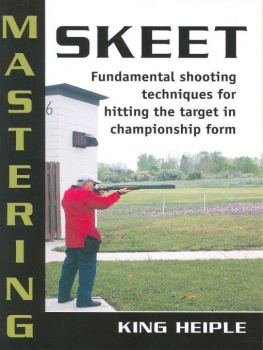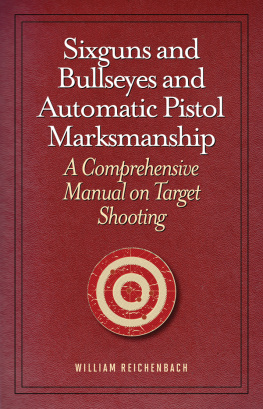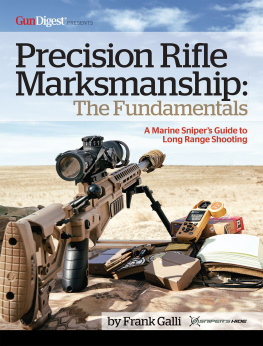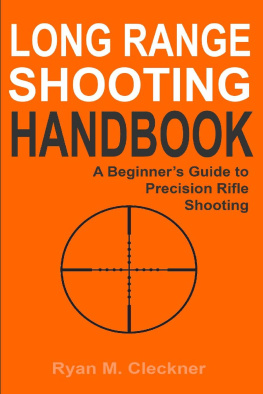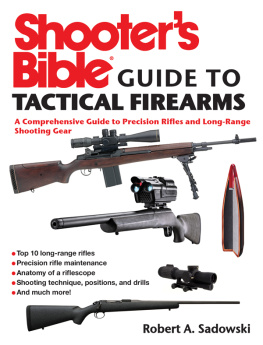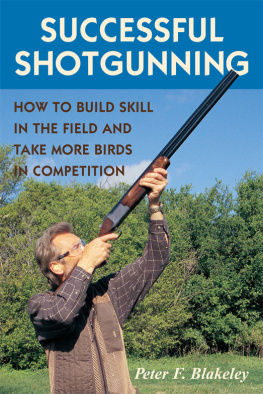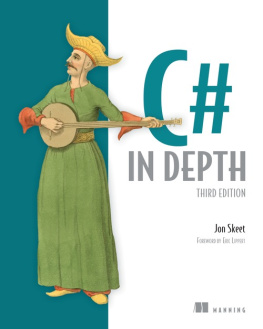Table of Contents
Copyright 2007 by King Heiple
Published by
STACKPOLE BOOKS
5067 Ritter Road
Mechanicsburg, PA 17055
www.stac.kpolebooks.com
All rights reserved, including the right to reproduce this book or portions thereof in any form or by any means, electronic or mechanical, including photocopying, recording, or by any information storage and retrieval system, without perenission in writing from the publisher. All inquiries should be addressed to Stackpole Books, 5067 Ritter Road, Mechanicsburg, Pennsylvania 17055.
Printed in the United States of America
First edition
10 9 8 7 6 5 4 3 2 1
Cover design by Wendy A. Reynolds
Cover photograph by King Heiple
Library of Congress Cataloging-in-Publication Data
Heiple, King.
Mastering skeet / King Hciple, with contributions by Todd Nelson.
p. cm.
Includes bibliographical references and index.
ISBN-13: 978-0-8117-3361-8 ISBN-10:0-8117-3361-0
1. Skeet shooting. 1. Nelson, Todd, 1967- II. Title.
GV1181.3.H45 2007
799.3132dc22
2006021225
Acknowledgements
Every author of an instruction manual owes gratitude to every previous author writing on the same subject, as well as all those who contributed directly to his or her own knowledge. I am certainly no exception. I wish that I could have personally thanked D. Lee Braun. I taught myself to shoot skeet by reading his Remington-published guide. Many others have had varying degrees of input into my knowledge and skill at this sport, including the late Bob Snyder, a Veteran World 28-gauge champion and shooting buddy for many years; Master Instructors Angelo Troisi, Don Suyder, Todd Bender, John Shima, and Ralph Aaron; Adrian Cousins, the first National Skeet Shooting Association Chief Instructor; Burl Branham, former coach of the U.S. Marksmanship Training Unit Shotgun Team; Lt. Col. Jack Horner, its former commander; and Dwight Davy, who supervised the skeet mechanics study in the appendix. I would also like to thank the many friends who encouraged and shot with me for many years, some of whom also appear in the illustrations: U.S. International Champion Dean Clark, Jim Murphy, Sue Huszai, Jack Albano, Doug DiPalma, Dick Cameron, Rich Cameron, Jim Doebereiner, George McCullough, and many more that I will regret having omitted.
Introduction
Skeet is easy, if youre happy breaking 9 out of 10 birds. But that means you have to be satisfied with shooting 22 to 23 birds out of 25 most of the time. Are you delighted when you manage a 25 straight, with high-fives all around? So am I, but only if I can do it consistently. If an occasional 25 is your goal, you dont need this manual. With three or four lessons, along with 20 practice sessions, you could shoot an occasional 25, even if this is your first season at skert. This book is addressed to those who want to break out of their comfortable, complacent shooting habits, whether beginners or AAA shooters. If your serious goal is 100 straights, this maaual can help you achieve it.
All the material in my previous short manual is included in this book, but with a great deal more background, illustrations, and amplification. There is an overriding emphasis on the basics, because even many excellent shooters overlook these details. If you are already shooting AA to AAA scores at skeet, you may think that a lot of the material in this manual is too basic for you, and you may be right, but you can never be overcommitted to the basics of your technique. A surprising number of top shooters have odd quirks in their shooting technique that probably cost them a bird on occasion. But if you watch top-level AAA shooters carefully, you will see how precise their technique is.
This text includes new material about the geometry and flight dynamics of a skeet target and how we perceive it. A portion of it is derived from a senior thesis done some years ago at Case Western Reserve University School of Mechanical and Aerospace Engineering, under the direction of Professor Dwight Davy and myself. Some of these data are included throughout, as well as in the appendix.
My conviction is that you can never know too much about the mechanics of whatever you are trying to accomplish. This is not to say that shooters with instinctive, natural styles cant break 100 straight; a few of them have even won national titles. But I characterize these successes as a triumph of athletic skill and practice over technique. These shooters tend to be streaky, shooting an excellent score on a day when theyre in the zone and crashing and burning when theyre not. They occasionally win a tournament despite their basically weak technique, but certainly not because of it. I believe that the more you understand about the mechanics of excellent technique, the closer you will come to championship form, and hopefully, championship achievements.
However, no amount of studyof this or any other manualwill automatically make you into a AA or AAA shooter and a top-gun threat at every match. You need excellent eye-hand coordination, reasonable athletic skill, and a commitment and willingness to put in plenty of practice. And because there is simply no way that you can stand behind yourself and see your own errors, you also need coaching, whether by a professional or by an experienced shooting friend. A pro is probably best, because we all tend to take advice we pay for much more seriously than that of idle friends, and the professional wouldnt have lasted very long if his or her coaching wasnt effective.
There are three fundamentals in skeet:
1. Keep your eye on the target.
2. Keep your head (actually, your cheekbone) on the stock.
3. Have the proper lead at the instant the shot clears the barrel.
But these fundamental only tell you what you must do, not why they are so critical or how to achieve these goals. This manual delves into the why and how of technique. I am convinced that it can be very helpful to understand why a certain skill might be able to earn you an extra bird per 100. Only then will you be willing to invest the necessary time and effort to incorporate it into your shooting style.
We all learn differently, and we frequently use a combination of learning techniques to acquire any new information or a new skill. Listening to advice, reading books, seeing photos or videos, watching a high-level performance, coaching, and repetitive practice of good technique are all part of learning. The advantage of a written manual is that it lets you stop and ponder what you just read or go back and reread a page. You can pick it up any time for quick reference. And it can cover the same material in much more detail than any video can. This manual is an effort to present excellent technique in skeet shooting in as much detail as possible, because practicing with poor technique doesnt lead to progress or real improvement, even though your scores may rise to some degree.
The biggest deficit of any manual or video, however, is that it cant see your errorsof both commission and omission. Thats where expert coaching comes in. If your coach has some favorite techniques that vary from this text and they work for you, thats fine. Unfortunately, your worst enemy in developing good technique is frequently your shooting friends. They offer loads of advice, but its rarely useful. Even if they know where you shot, they have no idea why you did so or how to correct it, which is the crux of the matter.
Be warned that when you apply basic technical corrections to an established shooting style, you may temporarily feel frustrated and may suffer a decrease in scores. Any change is uncomfortable at first, and unless you persist and work through it, you wont achieve your goal.

